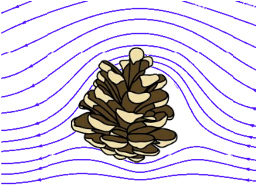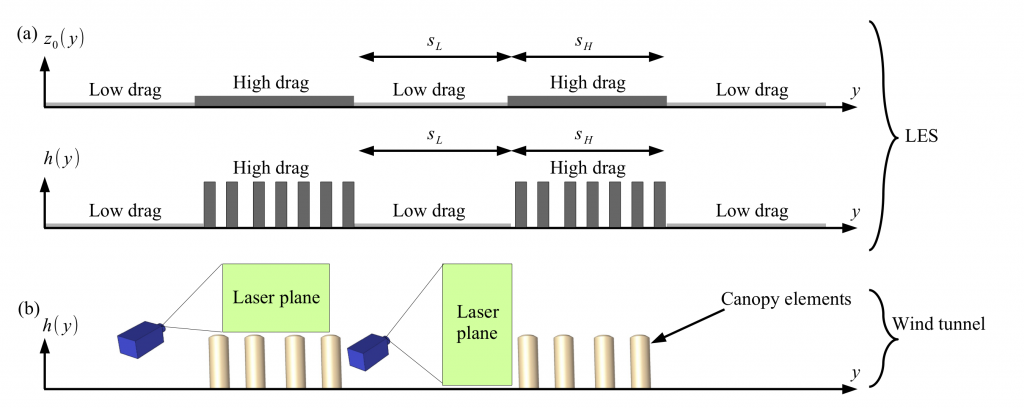Experimental study of the effect of spanwise landscape heterogeneities on the hydrological cycle in the atmospheric boundary layer
Joint NSF-BSF GeoSciences, Grant no: 2018615
Link (in hebrew): https://www.facebook.com/1801754670085138/posts/2449648885295710/
Principal investigators:
R. van Hout, Faculty of Mechanical Engineering, Technion-IIT
D. Liberzon, Faculty of Civil and Environmental Engineering, Technion – IIT
W. Anderson, Department of Mechanical Engineering, University of Texas at Dallas
Students:
Ewelina Winiarska (PhD)
Harel Klopfer (MSc), Ran Sofer (MSc)
Since the earth’s surface is always heterogeneous to some extent, the topography plays a significant role in the surface fluxes of momentum, heat, humidity and other quantities including dust and pollen. The variation of these fluxes as a result of land-atmosphere interactions has important implications for the hydrological cycle. These processes become even more relevant in desert – like, arid environments, where water management is essential for agriculture. Despite the fact that existing concepts of boundary layer structure are not necessarily applicable over heterogeneous surfaces, they provide a useful and necessary starting point. Observations made over flat homogeneous surfaces show that the Monin-Obukhov similarity theory (MOST) provides a good description of surface fluxes in atmospheric boundary layer (ABL), but it fails in a layer extending from the ground with sharp heterogeneities represented for example by canopies (Chen and Schwerdtfeger 1989).
In the past decades, substantial progress has been gained in understanding the formation of the internal boundary layer (IBL), which develops when the wind flowing over a uniform terrain encounters a step-change in surface conditions such as roughness, temperature, moisture or heat fluxes. Especially in the particular scenario when the variation in surface roughness parameters, namely the roughness lengths and displacement height, induces as mooth to rough transition. In these conditions, the IBL is formed at the transition and it grows in thickness downwind of the transition. Furthermore, other consequences of the sudden change in roughness that must be taken into account are the growth of surface wall stress and the development of turbulence in the areas upwind and downwind of the transition. The above-mentioned effects introduce perturbations in the mean flow, which change the boundary layer and thus undermine the validity of the MOST. In recent years, given the importance of the boundary condition on the dynamics of the flow near the ground, different authors carried out large-eddy simulations (LES) with the goal of obtaining physically more realistic boundary conditions. An important LES parameterization study applied in neutral atmospheric flow over heterogeneous land surface consisted of evaluating the effects of the variation of the parameters characterizing surface roughness (Bou-Zeid et al. 2004). This study revealed the significance of knowing regional-scale surface roughness for the analysis of hydrologic and atmospheric processes.
Hence, an experimental study on the effects of spanwise landscape heterogeneities in the atmospheric boundary layer is of paramount importance to address the challenges for the local description of surface fluxes required for weather and climate conditions forecast models and microscale hydrologic processes. To pursue the goal of investigating spanwise heterogeneities and induced turbulent secondary flows in the context of sharp landscape heterogeneities, a combination of high-fidelity laboratory measurements in the environmental wind tunnel located at the Technion’s Civil and Environmental Engineering Faculty (EWT),and LES modelling (to be conducted by the research team at UT Dallas, US) is planned. Wind tunnel measurements offer a highly controlled environment, highly accurate measurements and repeatability, which is particularly important for characterizing the parameters governing the induced flows. Wind tunnels arewidely used for turbulent boundary layer flow measurements inside and above landscape heterogeneities (Raupach et al. 1980, Raupach et al. 1986, Cheng and Castro 2002).
During the experiments care will be taken to design the topographic arrangements simulating aerodynamically rough and smooth zones. Arrays of strips of canopy elements will create rough areas laterally adjacent to smooth zones, allowing investigating smooth to rough flow transition and its implications. The investigation of flow processes at different locations in the vicinity of spanwise heterogeneity will be done using particle image velocimetry (PIV) and hot-wire anemometry. Further, moisture fluxes will be measured as a result of the combination of flow field, temperature and relative humidity conditions. Moreover, as commonly used when dealing with diurnal heating in complex topography arrangements during the laboratory measurements (Chen et al. 1996), a differential thermal forcing (heating/cooling) will be applied.
The T-SAIL (Technion Sea-Air Interactions Research Laboratory), the EMPFL (The Environmental Multi-Phase Flow Laboratory) and EWT laboratories, available for this proposed research, are equipped with advanced technology to allow the investigation of the above mentioned specific processes.


